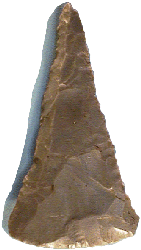

Point Type: COBBS
TRIANGULAR
Also See: Abasolo, Decatur , St. Charles
(Dovetail),Lerma, Lost Lake
Location: Southeastern States
Associated Dates:
8000 - 5000 B.P. - Early Archaic to Mid Archaic
Morphology: Lanceolate
General Description: The Cobbs Triangular is a medium to large sized early biface knife blade that is thin, with a broad rounded to square base. One side of each face is usually steeply beveled. The basal edge is usually flaked in detail, and can be slightly rounded or excurvate to incurvate. It base is usually ground. The basal edge on some specimens is more steeply flaked along one face. The cross section of the blade is typically a flat rhomboid. It is hypothesized that these were used as knives or were un-notched preforms for early Archaic beveled types such as the Decatur, Dovetail, Lost Lake, etc.
The Cobbs Triangular can range in size from 59 mm to 125 mm in length. The type was named by Horace Holland for examples which he recovered from the Cobb's plantation near Leighton, Alabama.
About the Point Above: The point pictured at the top of this page, is from Wickliffe, Ballard Co., Kentucky. It is made from satin grey colored flint. It measures 64 mm in length, 33 mm wide at the corners of the base, and is only 7 mm at its thickest point in mid blade. The base tapers down to 5 mm in thickness and does not appear to be ground and is evenly flaked from both faces. The blade is steeply beveled on each alternating side (lower blade edge in photo shows one of the bevels). The outline of the cross section is rhomboidal. The base is exurvate. The blade edges are incurvate. The distal end is rapier-like, quite sharp and also thickish and not tapered or thinned. No blade edge use is evident under high magnification. Catalog Number 31-19-C
References: Justice, Overstreet
© Copyright 1997 - 2008 LITHICS-Net WWW.LITHICSNET.COM
Use your Browser's BACK Button to return to the LITHICS-Net Index.